Growing plants without soil might feel like science fiction, but it’s simpler than you think. With a nutrient-rich water solution, you can cultivate lush greens faster than traditional methods. But like any system, things don’t always go as planned. A small pH imbalance or clogged pump can disrupt your entire setup.
Root rot, algae blooms, and unwelcome pests are frequent hurdles. These issues often stem from overlooked details like water temperature or inconsistent maintenance. Urban growers from New York to Los Angeles share similar stories—success depends on catching problems early.
Why does this matter? Your plants rely entirely on the environment you create. A well-balanced setup ensures nutrients reach roots efficiently. Think of it like a car: regular check-ups prevent breakdowns. Tools like pH meters and air stones become your best friends here.
This guide blends practical fixes with tips from commercial growers. You’ll learn how to spot warning signs and keep your plants thriving. Let’s turn those challenges into stepping stones for a healthier, more productive garden.
Key Takeaways
- Hydroponics replaces soil with nutrient-rich water for faster growth
- pH imbalances and poor maintenance cause most system issues
- Root health directly impacts plant vitality in soilless setups
- Proactive monitoring prevents common setbacks like algae or pests
- Urban gardening success relies on tailored troubleshooting strategies
Introduction
Imagine harvesting fresh greens year-round without a single speck of dirt under your nails. Soilless growing systems let you nurture plants using mineral-rich water, transforming tight spaces into productive green zones. Whether you’re in a studio apartment or a rooftop setup, this method delivers vibrant results faster than traditional soil-based approaches.
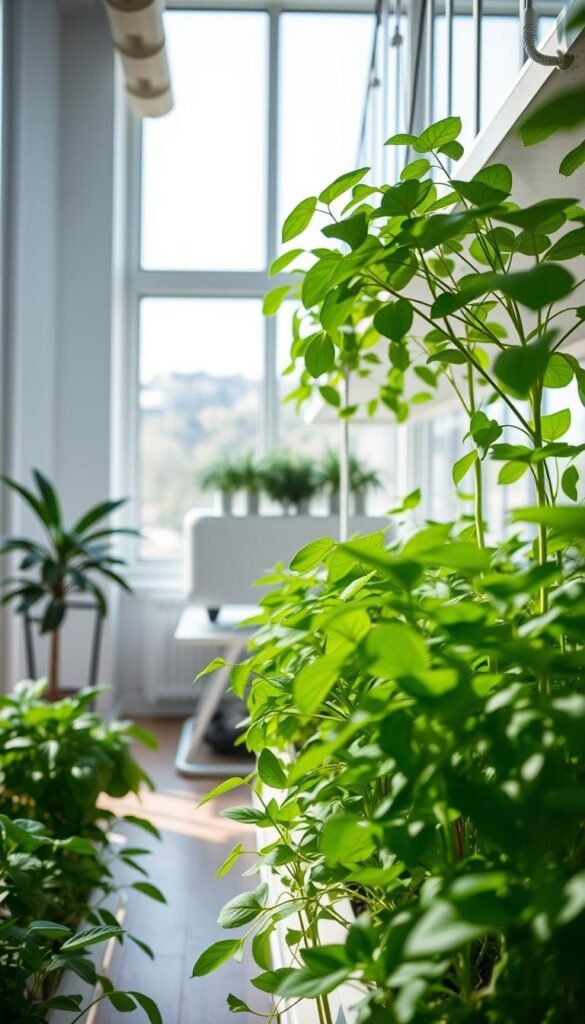
Overview of Hydroponic Gardening
This innovative approach skips the dirt and delivers nutrients directly to roots through customized solutions. You gain complete control over three critical factors:
- Light exposure for photosynthesis
- Nutrient mix tailored to each plant’s needs
- Oxygen levels in the root zone
Urban growers love how these systems maximize vertical space while slashing water use by up to 90% compared to conventional methods. Your garden becomes a precision tool—adjust one variable, and you see changes in growth rates within days.
Why Timely Troubleshooting Matters for Your Garden
Small issues like murky water or drooping leaves can snowball quickly. Since your plants depend entirely on the system you’ve built, daily check-ins prevent minor hiccups from becoming full-blown crises. Catching a pH drift early or spotting clogged tubes before roots suffocate keeps your green haven thriving.
Fundamentals of Hydroponic Gardening
Forget about soil—modern gardening thrives on precision and water-based systems. This method delivers nutrients directly to plant roots, creating faster growth cycles and cleaner setups. But mastery requires understanding both its advantages and the tightrope walk of maintaining balance.
What is Hydroponic Gardening?
Hydroponics replaces dirt with mineral-rich solutions that feed crops. Roots grow in inert mediums like clay pebbles or coconut fiber, which anchor plants while letting oxygen flow freely. Unlike soil farming, you control every nutrient dose and pH level.
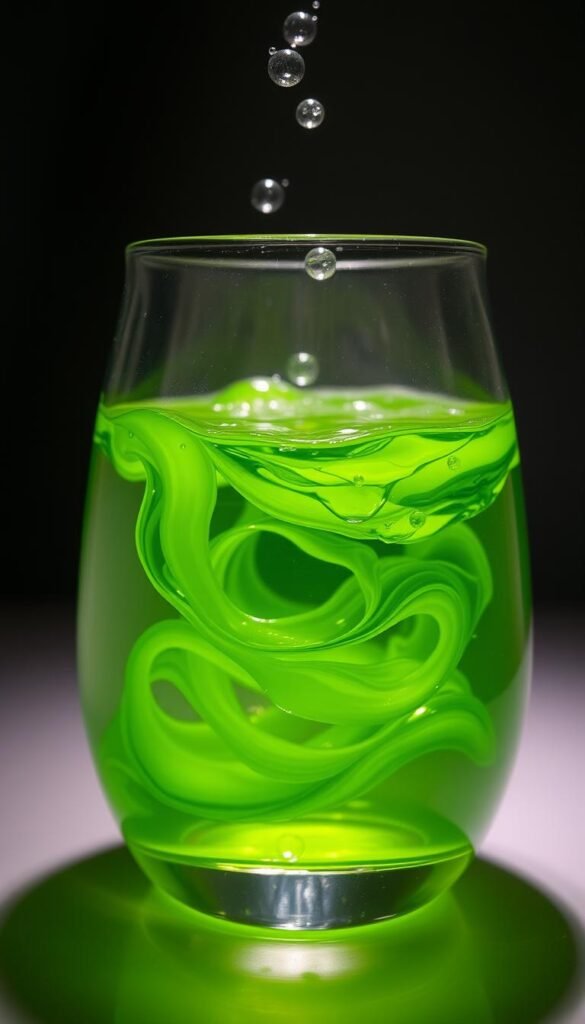
- Custom nutrient mixes tailored to each crop
- Precise oxygen delivery to prevent root rot
- Regular monitoring of water chemistry
Benefits and Unique Challenges
Soilless systems shine in urban spaces—vertical towers grow lettuce in 30% less time than traditional methods. You’ll use 90% less water while doubling yields. But there’s a catch: mistakes with pH or nutrient ratios can trigger lockout, where plants starve despite ample food.
| Aspect | Hydroponics | Soil Gardening |
|---|---|---|
| Growth Speed | 20-50% faster | Standard rates |
| Space Needed | Compact setups | Large plots |
| Water Usage | 10-20 gallons/week | 50-100 gallons/week |
| Common Issues | pH swings, root health | Weeds, soil pests |
Stick to a testing schedule. Check solution strength daily and scrub reservoirs weekly to avoid algae. When done right, your plants will reward you with explosive growth—no dirt required.
Troubleshooting Common Hydroponic Garden Problems
Your plants communicate through subtle cues long before major issues surface. Spotting these signals early can mean the difference between a quick fix and a system-wide crisis. Think of wilting stems or unusual spots as your green friends sending an SOS.
Reading the Leaves (and Roots)
Yellowing foliage often shouts “nutrient imbalance!” while brown edges whisper “pH trouble.” Check under leaves for sticky residues or tiny webs—pests love hiding there. Healthy roots should look creamy-white, not slimy or brown. A funky smell? That’s your cue to investigate further.
Your Action Plan for Healthy Plants
Start by testing your solution’s pH and EC levels—deviations here cause 80% of growth issues. Next, inspect roots for discoloration or mushiness. If you spot invaders like aphids, mix 1 tsp neem oil with a quart of water for a gentle spray. One urban grower shared: “Catching spider mites early saved my basil crop—weekly leaf inspections are non-negotiable.”
Track changes in water clarity and plant vigor using a simple journal. Swap out 30% of your nutrient mix weekly to prevent salt buildup. Remember, consistency matters more than perfection. With these steps, you’ll turn potential disasters into minor speed bumps.
Preventing and Managing Nutrient and pH Issues
Your plants’ vibrant leaves and sturdy stems depend on invisible chemistry happening in their root zone. When this balance falters, growth slows or stops entirely. Let’s explore how to keep your nutrient solution working for your plants rather than against them.
Understanding Nutrient Deficiencies and Lockout
Yellow stripes on leaves or purple stems often signal missing nutrients. Lockout occurs when roots can’t absorb minerals—even if they’re present in your water. This usually happens when pH levels swing too high or low.
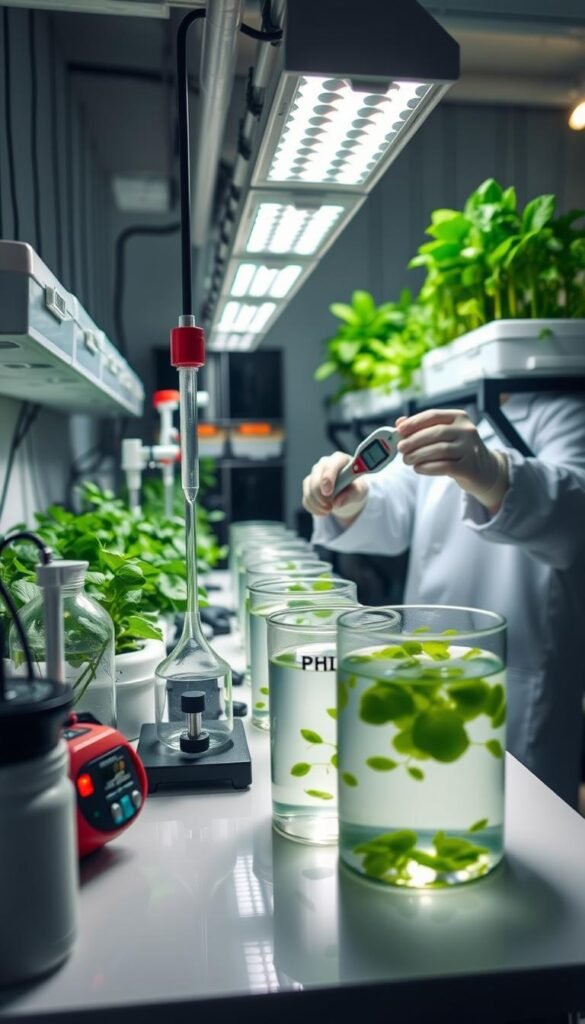
- Check EC (electrical conductivity) to measure nutrient strength
- Flush reservoirs monthly to prevent salt buildup
- Use calcium-magnesium supplements if leaf edges brown
Maintaining Optimal pH Levels for Healthy Growth
Most crops thrive when your water stays between 5.5-6.5 pH. Outside this range, iron and phosphorus become nearly impossible to absorb. Keep a digital meter handy—paper strips lack precision for delicate nutrient solution balancing.
| Plant Type | Ideal pH Range | Critical Nutrient |
|---|---|---|
| Leafy Greens | 5.5-6.0 | Nitrogen |
| Fruiting Plants | 6.0-6.5 | Potassium |
| Herbs | 5.8-6.4 | Calcium |
Adjust gradually—sudden pH shifts stress plants. One commercial grower notes: “We tweak by 0.2 points daily until we hit the sweet spot.” Pair this approach with fresh water changes every 2-3 weeks for consistent results.
Controlling Pests, Diseases, and Algae
Even the cleanest setups can face unwelcome visitors. Tiny invaders and green slime love nutrient-rich environments as much as your plants do. Staying one step ahead keeps your crops safe without harsh chemicals.
Effective Strategies Against Pests and Pathogens
Spot aphids or spider mites? Mix 2 tablespoons of neem oil with a gallon of water for a natural spray. Wipe leaves weekly to disrupt pest life cycles. A Brooklyn grower shared: “Yellow sticky traps caught 80% of my fungus gnats within three days.”
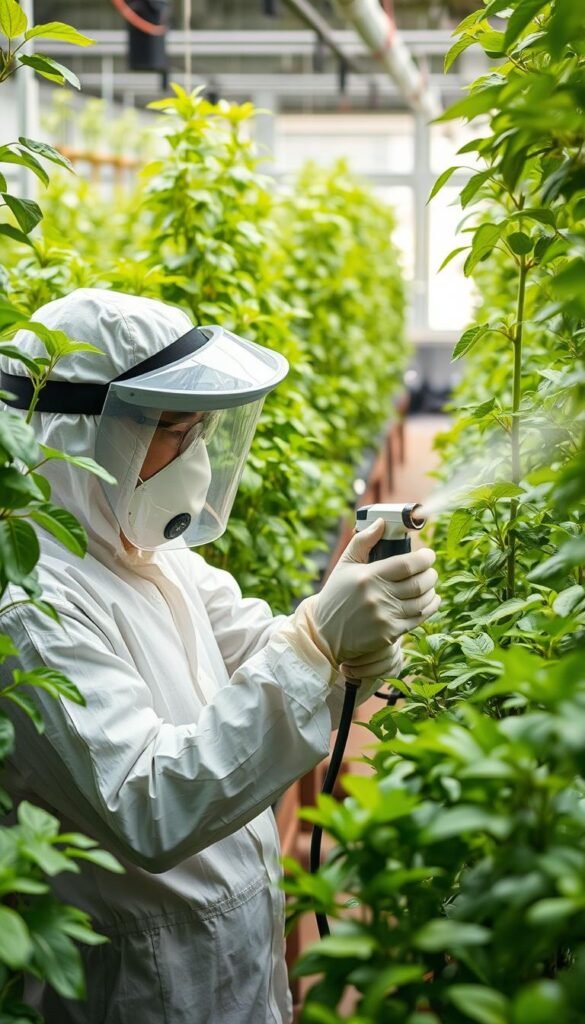
Diseases spread fast in moist conditions. Remove infected plants immediately to protect others. Boost air circulation with small fans—stagnant air invites mold and fungus. Sanitize tools between uses with a 10% bleach solution.
Preventing Algae Growth in Your System
Block light completely from your reservoir—black tubing and opaque lids work best. Scrub surfaces monthly with hydrogen peroxide to remove algae spores. For stubborn cases, add 1ml/gal of food-grade algaecide during water changes.
Keep roots healthy by maintaining water temperatures below 75°F. High heat accelerates algae blooms and root disease. One Arizona gardener reported: “Adding ice packs to my reservoir twice daily dropped temps by 8 degrees.”
Optimizing Environmental Conditions and Equipment Maintenance
Your indoor oasis thrives when light, warmth, and airflow work in harmony. Like conducting an orchestra, each element must play its part precisely. Get this balance right, and you’ll see leaves unfurl faster while roots stay crisp and healthy.
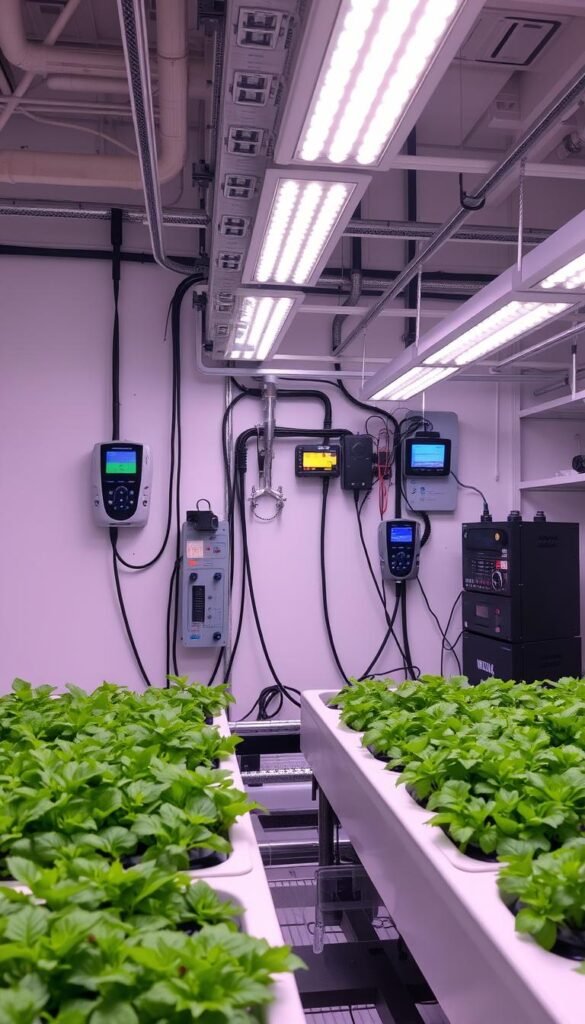
Balancing Lighting, Temperature, and Air Circulation
Most crops crave 14-16 hours of light daily. Use timers to mimic natural cycles—consistency prevents stress. Keep daytime temperature between 68-75°F, dropping 5-10 degrees at night. This daily swing mimics outdoor conditions, encouraging robust growth.
Position oscillating fans to create gentle air circulation without drying leaves. One urban farmer noted: “My basil doubled in size after adding a small fan—stagnant air was choking growth.” Pair this with proper spacing between plants to prevent moisture buildup.
| Plant Type | Ideal Light Duration | Temperature Range |
|---|---|---|
| Leafy Greens | 12-14 hours | 60-70°F |
| Herbs | 14-16 hours | 65-75°F |
| Fruiting Plants | 16-18 hours | 70-80°F |
Ensuring Proper System Maintenance and Leak Detection
Weekly inspections prevent 90% of equipment failures. Feel for damp spots under pipes and check pump vibrations—unusual sounds signal trouble. Use a simple checklist:
- Test water flow in each channel
- Clean filters with vinegar solution
- Inspect seals for wear
Seasonal changes demand adjustments. As days shorten, increase light exposure gradually. For detailed climate control strategies, track humidity levels with digital sensors. Remember: proactive care saves time and protects your crops from avoidable setbacks.
Conclusion
Mastering your soilless setup comes down to consistent care and quick adjustments. Regular checks of water chemistry and root health keep plants thriving. Spotting yellow leaves early or catching slimy roots can save your entire crop.
Balance is key. Test pH weekly and refresh nutrient mixes to prevent lockout. A Florida grower shared: “Tracking my solution’s EC levels doubled my basil yields.” Keep reservoirs clean and dark to block algae while ensuring proper oxygen flow.
Your daily attention matters most. Small tweaks to light schedules or water temperature create ideal growth conditions. Remember, vibrant plants start with proactive monitoring—those five-minute inspections add up.
With these strategies, you’ll turn potential setbacks into learning moments. Every challenge solved strengthens your green thumb. Now go nurture those plants into their best selves—your future harvest will thank you.






